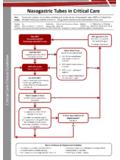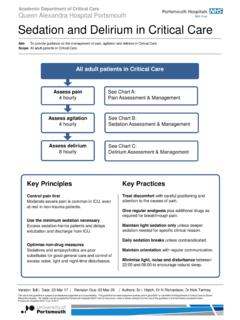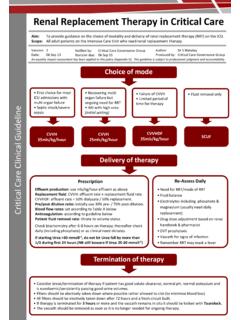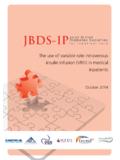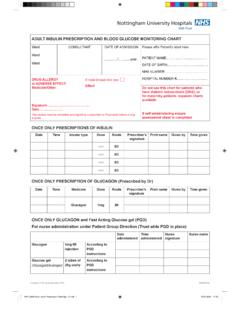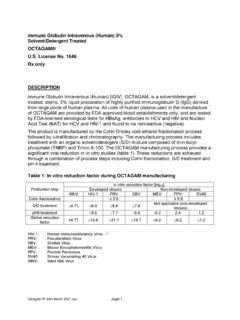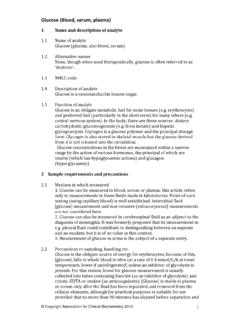Transcription of Insulin Infusion (Variable Rate) in Critical Care
1 Academic Department of Critical Care Queen Alexandra Hospital Portsmouth Insulin Infusion ( variable Rate) in Critical Care Aim To provide guidance on administration of variable rate Insulin Infusion on adult patients on DCCQ. Scope This applies to all adult patients on DCCQ receiving variable rate intravenous Insulin Infusion . It does not apply to patients requiring fixed rate Insulin Infusion patients suffering from diabetic emergencies such as DKA and HHS. Goals of variable rate intravenous Insulin Infusion 1. Treat and control hyperglycaemia in Critical care patients not normally on Insulin 2. To maintain euglycaemia in Insulin dependent diabetics who are unable to maintain enteral carbohydrate intake and/or unable or unsuitable for their regular subcutaneous Insulin . 3. To avoid harmful hypoglycaemia. Consideration to start variable rate IV Insulin Non-diabetic patients/ diabetic patients Insulin dependent diabetics not normally dependent on Insulin Confirm at least two consecutive BM Commence Insulin dependent diabetic readings >10mmol/L.
2 Protocol at a rate determined by blood glucose-see Insulin chart in Appendix B. Commence non-diabetic IV Insulin Consideration should be given outside of protocol at a rate determined by blood Critical illness or as Critical illness glucose-see Insulin chart in Appendix B resolves to restart long-acting Insulin alongside variable rate IV Insulin Infusion Prescription: Insulin should be prescribed as a continuous Infusion on CIS and also on the department's IV Insulin bedside paper prescription. Patient details should be completed on the paper chart, the target blood glucose range specified, the chosen regimen circled and signed by the prescribing clinician along with their printed name and date of prescription. Nurses should adjust rate against BMs according to this paper chart. Administration: Administer via syringe pump using 50 units in 50ml syringe of Insulin alongside a glucose containing Infusion (including enteral tube feeding providing patient is absorbing).
3 Use pre-filled pharmacy syringes. Monitoring: Check BMs hourly for 2 hours then 2-hourly for four hours if acceptable. Once stable and in target range go to 4-hourly monitoring. If BMs consistently out of range (>70% readings) consider protocol individualisation Version: | Date: 30 Jun 17 | Revision Due: 30 Jun 20 | Authors: Joseph Tooley, Critical Care Pharmacist The use of this guideline is subject to professional judgement and accountability. This guideline has been prepared carefully and in good faith for use within the Department of Critical Care at Queen Alexandra Hospital. No liability can be accepted by Portsmouth Hospitals NHS Trust for any errors, costs or losses arising f rom the use of this guideline or the information contained herein. Portsmouth Hospitals NHS Trust 2017. TABLE OF CONTENTS. 1.
4 Introduction 2. Purpose 3. Scope 4. Definitions 5. Duties and Responsibilities 6. Process 7. Training Requirements 8. Monitoring Compliance with, and the Effectiveness of Procedural Documents 9. References and Associated Documents Appendix A. Bed-side paper prescription chart intravenous Insulin for glucose control on Critical care dated 30 Jun 17. 2. 1. INTRODUCTION. Elevated blood glucose in critically ill patients is a common clinical finding and is associated with increased mortality and poorer outcomes. The aetiology of hyperglycaemia in Critical illness is multi-factorial and occurs in both diabetic and non-diabetic patients. Endogenous cytokines and hormones such as cortisol and adrenaline reduce Insulin production and increase Insulin resistance, promoting glycogenolysis and gluconeogenesis whilst impairing peripheral utilization.
5 Many of the Critical care therapies such as exogenous steroids and catecholamines further exacerbate the situation. However the results of the NICE-SUGAR study in 2009 indicate that overly aggressive glucose control with intravenous Insulin results in worse outcomes than moderate control due to increased tendency to develop hypoglycaemia. Thus Critical care practitioners must walk a fine line between avoiding harmful hyper and hypoglycaemia. 2. PURPOSE. The purpose of this guideline is to inform the safe use of intravenous Insulin for the control of blood sugars in critically ill patients. It guides the use of IV Insulin infusions (sometimes referred to as sliding-scale Insulin ) in diabetic and non-diabetic patients for the purposes of maintaining moderate euglycaemia. 3. SCOPE. The guideline covers all adult patients on DCCQ who require variable rate intravenous Insulin Infusion (VRIII).
6 The management of diabetic emergencies (DKA, HHS) with fixed rate Insulin is beyond the scope of this guideline. 4. DEFINITIONS. BM: Boehringer Mannheim test: A blood glucose measurement performed on a glucose meter IDDM: Insulin dependent diabetes mellitus NIDDM: Non- Insulin dependent diabetes mellitus DKA: Diabetic Ketoacidosis HHS: Hyperosmolar hyperglycaemic state HONK: Hyperosmolar non-ketosis-old fashioned term for HHS. VRIII: variable rate intravenous Insulin Infusion GLP-1 analogues: Glucagon-like peptide-1 analogues. Anti-diabetic medicines which are subcutaneously injected but are NOT Insulin . Examples include Exenatide (Byetta &. Bydureon ) and Liraglutide (Victoza ). Do not confuse with regular Insulin . 5. DUTIES AND RESPONSIBILITIES. The decision to implement this guideline is at the discretion of the on-call Critical care consultant.
7 Implementation of this guideline is the joint responsibility of appropriate Critical care medical/. nursing staff. This guideline is subject to professional judgment and accountability. intravenous Insulin for glucose control on Critical care dated 30 Jun 17. 3. 6. PROCESS. Action Rationale Inclusion Criteria All adult patients admitted to The protocol used in this guideline is based on the intensive care requiring variable NICE-SUGAR study which included type 1, type 2. rate intravenous Insulin Infusion and non-diabetic patients with hyperglycaemia admitted to intensive care. Exclusion Criteria *DKA/HHS *The management of DKA and HHS/HONK requires fixed rate intravenous Insulin Infusion with potentially large volumes of fluid delivered and close attention to the rate of decline in serum glucose. This is normally dictated and modified on case-by-case basis by the duty consultant and is outside the scope of this guideline.
8 *Paediatric patients *The NICE-SUGAR protocol was not validated in children whose Insulin sensitivity and fluid requirements are significantly different to that of an adult. The use of variable rate IV Insulin in paediatric patients on DCCQ is to be guided by the expertise of the duty consultant. In DCCQ Guidance *Patients should be stratified onto the .Patients with type 2 diabetes and non-diabetic correct protocol depending on whether patients experiencing hyperglycaemia will still retain they are Insulin dependent diabetics or some residual Insulin producing pancreatic function. non- Insulin dependent: Type 1 diabetics have no endogenous Insulin secretion and so require a basal level of Insulin even - Insulin dependent: Type 1 diabetics or within range to inhibit ketogenesis. Therefore it is type 2 diabetics established on necessary to have a protocol for each patient group.
9 Subcutaneous Insulin therapy at home -Non- Insulin dependent: Type 2 diabetics on tablets (or injectable GLP-1 analogues). or those with hyperglycaemia but not diabetic. *Prescribing clinician to complete paper Due to the limitations of CIS in guiding the nurse as Insulin prescription at the bed-space with to Insulin dosage and the high risk nature of the patient details filled in. Select, by circling, Infusion it is mandatory that all VRII prescriptions which regimen the nurse is to follow. Sign, have a paper chart as well as a CIS prescription print name and date underneath the prescription. *Prescribe on CIS intravenous Insulin The Infusion should be prescribed on CIS so that the Infusion . For VRII this is the option titled: rate of Insulin can be tracked on the system against - Insulin soluble (human) pre-filled syringe blood results and the volume can be included in the Ensure that the pre-set is properly patient's total fluid intake.
10 Selected so all details of the preparation including volume and concentration are carried across. *Continue patient's regular long-acting Hyperglycaemia and DKA have been reported in insulins particularly in type 1 diabetics type 1 diabetics who have variable rate IV Insulin once the patient is in the convalescent discontinued without long-acting agent already on phase of their illness or time on IV Insulin board. IV Insulin has a very short half life and effects intravenous Insulin for glucose control on Critical care dated 30 Jun 17. 4. Infusion is likely to be short. will dissipate in a matter of minutes once the Infusion is stopped. Physiologically a healthy pancreas produces a continuous background level of Insulin to suppress ketogenesis. Type 1 diabetics will not produce sufficient background Insulin on cessation of the Infusion and are at risk of DKA.
